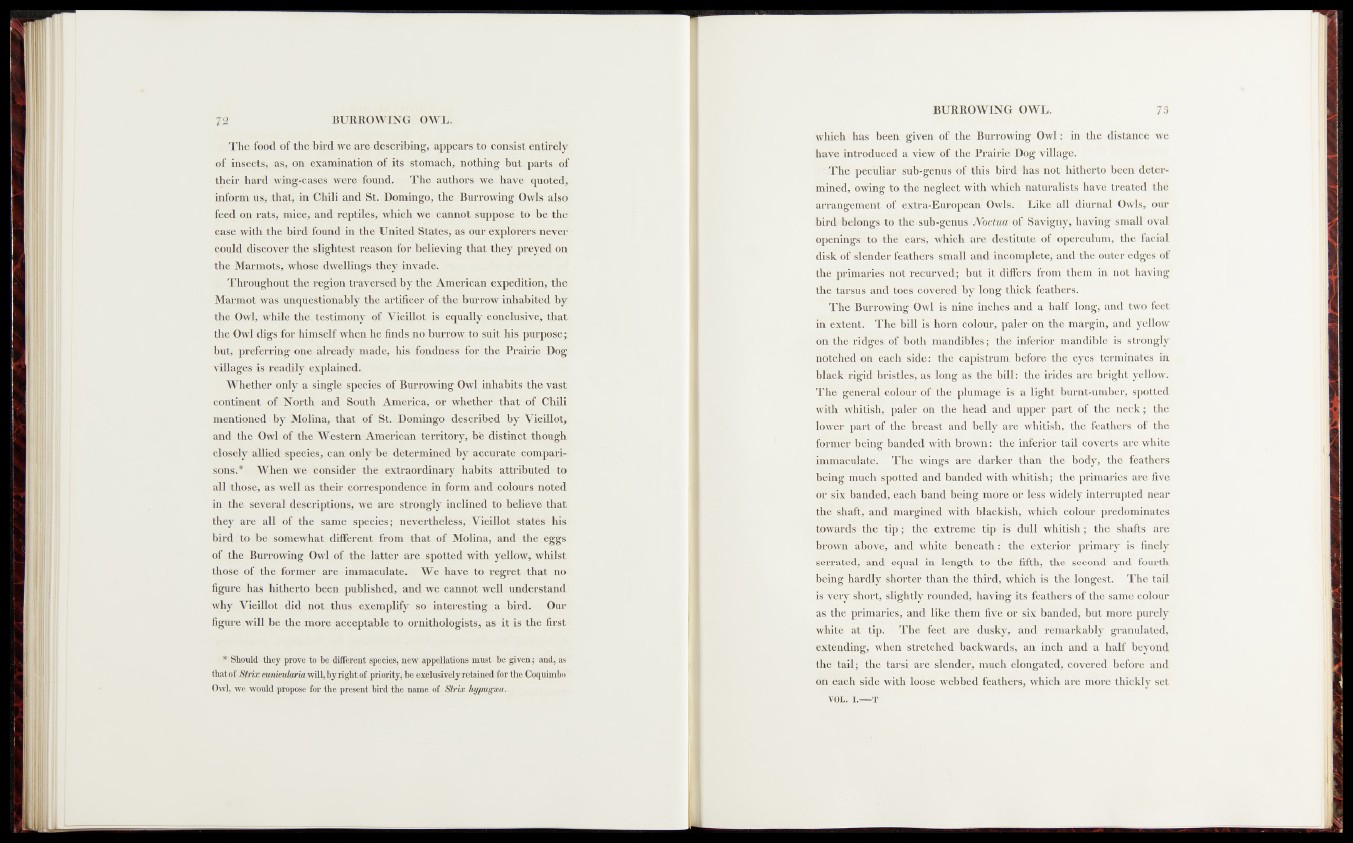
i ü BURROW®* OWL.
. The food of therbir.d^Ve ,ar,ë describing, appears tö consist fentirèly
of insects, u s^ n c ex animation of its stoma^h/rnöt-hkïg hut.paktsjqf
their. harvd%wdngBoasps:jw.er e>.found. The authors „w.e. have, "quoted?,
inform us,;that;.in:Ohili apd St. Domingo, the Burrowing Owls also
feed qnv&ats, .mice, and reptiles, which we- cannot suppose', topbe .thifcj
case .wdthithe bird found'in the United Stages,-as our explorers nevei*
could discover the .slightest reason-for hdliewa^ that they preyed on
the Marmots, whose dwellings they invade, n
Throughout the region.traversed’ by_thei American expedition, the
Marmot wasfnnq^'Sïidnably the artificer of the burrow inhabited byt
the Owl, while the! testimony -df Yifeiilol^iSia\qi'i(dIj^h’^il&üv th at
the Owl digs for himself when lie .finds no burrow to suit ■hisTpürpose ■
but,.preferring one-already made, his[fondnessTor the Prairie Dog:
villages isi readily explained.
Whether oMyja&aingle species df Burrowing. Owl inhabits the« #Üs%
continent efiNorth and South America, or whether that of Cliili
mentioned by Molina, that of St, Domingo. rdèMf|l^léb,yj|-YieilloL
and the Owl of the Western American territoryj. bë distinct^thqugh,
closely ;aMiejdl^pecies;>'cantbnlyvbe: determined by accurate cpmpari-
sons;* When- we^con&idër" the. extraordinary habits attributed?:to
all rthose, ;as' well as their correspondence in form andlcO’lours rnoted
in the several;descriptions,- we are strongly inclined fbtbelieye^that;
they are ijd!' of' the same species; nevertheless, Vieillot states his
bird ! to be somewhat different from that of Molina, and: the eggs
of the Burrowing Owl .of the latter are. spotted with yellow,, whilst
those-of the former are immaculate. We have.to regret .that no
figure has hitherto been published, and we cannot well understand
why Vieillot; dfdr.not. thus exemplify so interesting a bird. Our
figure will bédjie.more acceptable to ornithologists, as it is the first
♦ Should they-prove to be different species, new appellations must be given; and, as
thatof.jSSMa: cunicularia will, by right of priority, be exclusively retained for the Coquimbcx
Owl, we would propose for the present bird the name of Strix hypugm.
Which ha®'J>ccni gh^TW{|r)f'^l)he Burrowing Owl: in the distance we
havédhfioduéed a view-'bf||tle Prairie^ Dbg Village.
v'iThe pecilliar: sbb%enm3>of - this hffcd has- no%‘. hitherto been deter“
mined, ovfrng lo!/the£®egllGt- witb'v^ffil^liaturalists have treated thé
‘arraiigtmenr <mextra-European?Gwfl&L Like* all diurnal Owls', our
birdebelongs',t!0 the:sufe:genhs.t iStwignyVhaving small'Oval
Openings-fe: the- eaW,tw 1’rijhi l-ifute-<(i^OTeremum, tHe facial
disk o rd i ndcr 1 caflulaiwi'ij?aM'1 db d inwwiij)®tc^,Sn'(l’{he outer’edges-of
tlimidmane^nol- iei m ved; but llSfflJWs’from them in not baving
the tarsus and t()csï^^ru^w\>lcing 111Lcbs featnfers.
•'LlitTOn^owinKf0 \\ 1 isfnane inches and a h a l tmiig, and two feet
in extent. The bdl is:honfi ©Tmm^f.falelTon,, I lie margin, £wd yellow
qn the imigov of Ijfoth ’u i a i n f e r i o r mandibml ^ sfro n g l^
notched i ^pisfrum lsj?torG if ity eR i^ lVvn)'mates in
black rigid bristles, as long af llvD%i'fVT-lie iriucs art* m-iglit»yelrow'.'
The genèralMflnur nl''lf)c burnt-ui'nbej-t molted
with whitish?,. pah-i- (j^^npblicair and upper part öt.tn^necli'j’ the
jjM e rf^ r t ofRne breast and belhlurorwTirtLÏ^né fi .itlu rs of thé
former being banded with brown ? I®® inferior taiF coverts, a^ywmté
immaculamt Thcj^Kpfy are darker than thé bodlyf Ihe- feathers
Iplngfmuch fwt|e'd and Banded with whitish; the are
or six banded, eadh band being moreoifllls; widely m-ïöf;impted near
the shaft, and margined with blackish, whiTnr« olour predominates
towards the ti]i% ^ ^ ex&emef tlb » ^ dull wmf®M % the shafts are
browif afoye, and whifeL beneath the exterior primary is finelw
serrated,., and equal in length tdFtne fifth, th® sfjjcppai and fourth
being hardljf^nfiiftef thajSnpfe third, wnww P# thé' longest. 3 pie tail
is very short, slightly rounded, having its 'feaihVrs oftnesame colour
as the pi imarics, and Me them fivéfor six banded, but more purely
white at tipfêtf^Tnefueep: are dusky, anf^FSparkably "granulated’,
extending, when stretched backwards, ah- in&fl and a half beyond
the tail; the tarsi' are'^mrmef, muèn^rongatba,' 8hveï%d‘ before and
on each side with loose webbed feathers, which are more thickly set